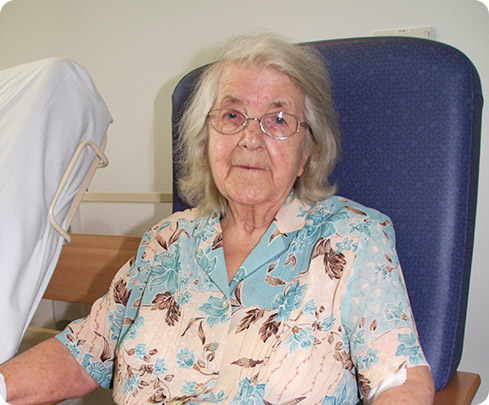Your views

Your feedback is vital to us as we continue to increase the quality of our services.
You are here:
Date: 26 December 2024
Time: 08:27

96-year-old gets micro pacemaker
Story posted/last updated: 15 July 2015
A 96-year-old woman has become one of the first patients in the United Kingdom to receive the world’s smallest pacemaker at Queen Elizabeth Hospital Birmingham (QEHB).
Elsie Day was implanted with the Medtronic Micra by consultant cardiologists Professor Francisco Leyva and Dr Howard Marshall at the hospital on June 30.
Mrs Day is among the first in the country to benefit from the cutting-edge device as QEHB continues Birmingham’s pioneering history in heart surgery and pacemaker technology.
After a successful procedure she was looking forward to getting back to her Bourneville home, where she looks after husband Ernest, who is 103 in July and has already had a traditional pacemaker fitted at the QEHB.
The tiny Medtronic Micra was inserted via Mrs Day’s inner thigh and threaded through veins until it reached her heart, where it will help to regulate her heartbeat.
The £6,000 torpedo-shaped device has been under development for a number of years. Successful trials have been carried out in the United States, Germany and at Southampton General Hospital, but it has only recently become generally available to patients in the UK.
Traditional pacemakers are inserted under the skin in the chest and connected to the heart via a lead but this new device can be implanted directly to the heart, removing the need for any wires or leads.
Professor Leyva said: “This new pacemaker has a number of benefits for the patient.
“The implantation procedure is a lot less intrusive and, once in place, the lack of any wires drastically reduces the risk of complications or infections developing.
“This is really the first generation of a whole new type of pacemaker that will be used in the future. It represents the transformation of heart pace-making.”
Mrs Day was delighted with her new pacemaker, although admitted to being a little puzzled by the cutting-edge technology.
“I feel very happy about it,” she said. “It’s in now, and I think it will make such a difference for me when it settles down.
“When the doctor first told me about the operation I wondered how it would get from my leg up to my heart but he explained everything to me. Everyone has been so lovely, very kind and caring.”
Before the implant Mrs Day’s failing heart had led to difficulties getting around, dizziness and falls – one resulting in a fractured skull which was also treated at QEHB.
Daughter Gillian Withers, of Halesowen, said the pacemaker would allow her mother to retain her independence.
“Mum and Dad live alone and she is effectively Dad’s sole carer,” she said. “We visit every day but she still insists on doing all her own cleaning around the house and takes the ring and ride service to do her weekly shop.
“Being independent is important to her and everyone at the hospital understood that and how much this pacemaker would mean to her.”
Birmingham has a reputation for leading the way in heart surgery stretching back 65 years.
In 1950, the first hole-in-the-heart surgery was carried out at Birmingham Children’s Hospital.
And in 1960 Queen Elizabeth Hospital surgeon Leon Abrams fitted the first variable-pace pacemaker, which took the form of a small box outside the body.
He designed the pacemaker with electronic engineer Ray Lightwood. It was marketed by Lucas Industries as the Lucas-Abrams Pacemaker.
Mr Abrams also set up one of the UK’s top centres for lung and heart surgery at the hospital and established open-heart surgery on the site.

Getting here
Information about travelling to, staying at and getting around the hospital.

Jobs at UHB
A great place to work. Learn why.
news@UHB


RSS feed
Subscribe to our news feed


